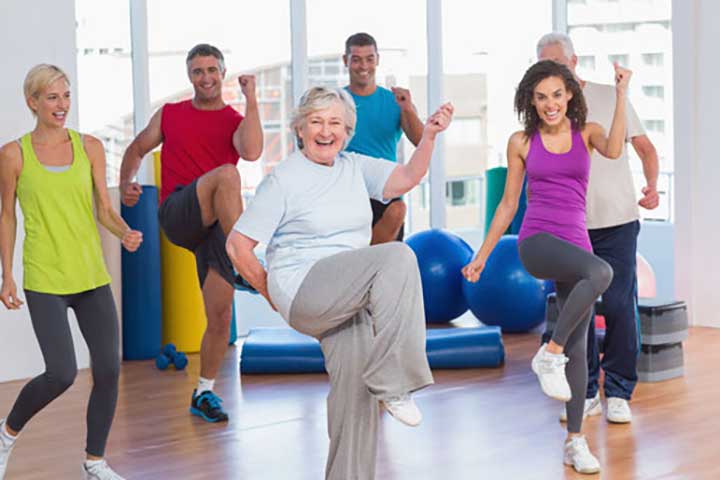You know exercise should be part of your daily routine. But who has the time or the energy? After all, you can hardly find time for the demands of your job and your family.
Still, you know that finding time for everything except regular exercise is unhealthy. To look, feel, and be fit, you need exercise. And as a nurse who does so much for so many others, you deserve the benefits of good health.
Perhaps the top reason for unhealthy behaviors among nurses is what I call the type E personality. Nurses do everything for everyone except themselves. Unfortunately, this selfless approach puts your health and wellness at the bottom of your priority list.
What you’ll gain, what you’ll lose
Let’s face it: Many nurses aren’t the picture of health, and they struggle with their body image. Focused physical activity can make you feel proactive about losing body fat, toning up, and gaining a more positive body image.
Successful long-term weight management requires daily physical activity. Such activity allows you to eat more while losing body fat. That’s because exercise raises your metabolism, counteracting your body’s
attempt to slow it when you begin losing weight. One pound of fat burns no calories. One pound of muscle burns 50 calories a day.
Also, daily physical activity can profoundly improve your emotional and physical health. It can lower your blood pressure and cholesterol level, decrease the severity of diabetes, and help with mild depression. It can also make work-related stress melt away. Physical activity raises your endorphin level, so you can cope more effectively, and it gives you more energy to meet the demands of your day.
All these benefits have a ripple effect on your family. By doing something for yourself, you gain energy, cope with stress more effectively, and feel better about yourself, making you a happier person to be around.
Your daily routine
So how do you manage to incorporate exercise into your daily routine?
First, identify the physical activities you like—perhaps walking, dancing, bike riding, ice skating, or playing tennis. If you start your new commitment to exercise by performing activities you don’t enjoy, you probably won’t stick with it for long. (See New ways of walking in pdf format by click on the download now button.)
Second, you need to make exercise a priority by scheduling it. You may be thinking that because you work long shifts and are extremely busy, you barely have time to eat let alone exercise. But that’s exactly why you must make exercise a priority. You need to schedule exercise time either before or after your shift. Also, schedule exercise time for the days you have off. It’s simple really: If you don’t schedule your exercise, you won’t exercise.
Fitness classes at work can help you schedule and perform exercise regularly. So, too, can a workout buddy. Your buddy can be another nurse, your spouse, or your dog—assuming that one of your selected activities is walking.
Getting going
An easy way to start incorporating physical activity into your life is to take daily walks. Walking is a terrific way to get fit and lose weight. Plus, it doesn’t cause wear and tear on your body. After consulting your physician and getting the go-ahead to begin exercising, you can start walking on a treadmill or around your neighborhood.
Your initial goal is to walk at least 2 miles a day, using a pedometer or a treadmill. If you use a treadmill, start by walking at 3 miles per hour. You can start slowly and gradually increase your speed to 3 miles per hour, as you warm up. If your treadmill has resistance options, you can gradually increase resistance, as desired. Record how long it takes you to walk 2 miles.
Continue to walk 2 miles every day. Before increasing the distance you walk, try to shorten the time for your 2-mile walk. Then, increase your distance to 21⁄2 miles a day. Over a period of months, increase your mileage and decrease your time. Your heart and other muscles will become stronger and more efficient, and you’ll lose body fat and tone up.
For walking exercise at home, I use a nonmotorized treadmill. It’s sturdy and inexpensive, and I can fold it up when I’m not using it. This type of treadmill is great for walking, but I don’t recommend it for jogging because you have to supply the power.
Beyond walking
If you don’t want to walk, pick other activities that increase your heart rate, such as cycling, swimming, dancing, aerobics, kick boxing, or jogging. Perform your activity at least three times a week. (See What does it take to burn off those calories? in pdf format by click on the download now button.)
After you build your aerobic endurance, you can add weight training two or three times a week. Remember, 1 pound of muscle burns 50 calories a day. Work with a certified personal trainer or exercise physiologist to learn proper techniques and reduce the risk of injury. At home, use an exercise video and exercise tubes. You should perform the appropriate exercise for each of the major muscle groups:
• bicep curl for the biceps
• tricep extension for the triceps
• chest press for the chest muscles
• seated row for the back
• leg extensions for the quadriceps
• side-lying adduction for the inner thighs
• side-lying abduction for the outer thighs.
Perform 8 to 12 repetitions per set and do two or three sets. Choose one day for the upper body and another day for the lower body.
Be healthier, feel better
Making a commitment to ongoing exercise isn’t easy. But it is rewarding. Scheduling and performing your daily exercise will improve your health, increase your energy, and make you feel better about you.
Gary Scholar is a Health and Wellness Consultant in Chicago, Illinois.



















1 Comment.
I found this article very informative. Also I must say this is the first time I have read your journal on-line. I hope to read many more articles. !